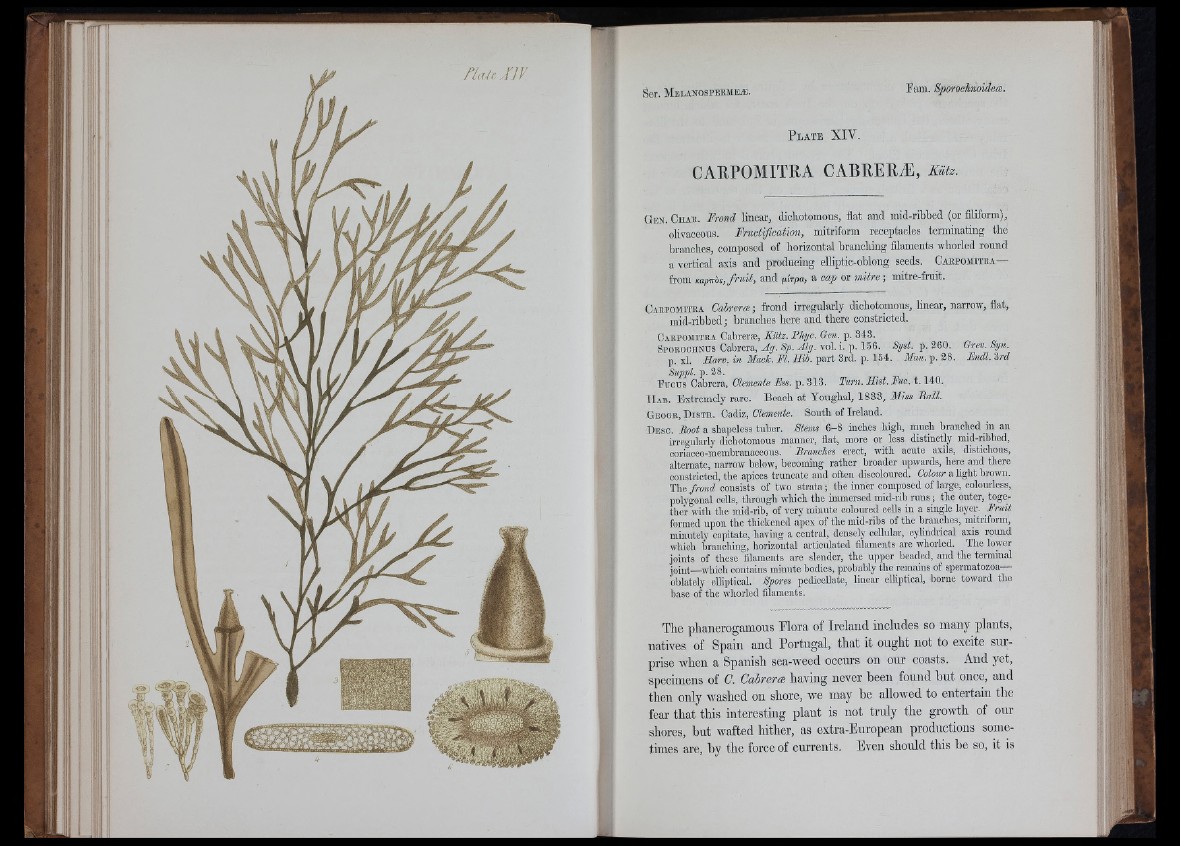
/U k ' J J K
' 'Ii
! II!
1 Li
P l a t e XIV.
CARPOMITRA CABRERaE, fife.
Gen. Chab. Frond linear, dichotomous, flat and mid-ribbed (or filiform),
olivaceous. Fructification, mitriform receptacles termina ting the
branches, composed of horizontal branching filaments whorled round
a vertical axis and producing elliptic-oblong seeds. C a k p om itb a—
from Kapm z,f r u i t , and f r p a , a cap or mitre-, mitre-fruit.
Cabp omite a Calrerm -, frond irregularly dichotomous, linear, narrow, flat,
Grev. Syu.
Endl. 3rd
mid-ribbed; branches here and there constricted.
C a b p o m it e a Cahrerse, Kiitz. Phyc. De». p. 343.
Spo r o c h n u s Cabrera, Ag. Sp. Alg. v ol. i. p. 156. Syst. p . 360.
p . xl. Harv. in Mack. El. Hib. part 3rd. p . 154. Man. p. 38.
Suppl. p. 28.
Fucu s Cabrera, Clemente Ess. p. 313. Turn. Hist. Fue. 1 .140.
I I ab. Extremely rare. Beach at Youghal, 1833, Miss Ball.
Geogr, Distr . Cadiz, Clemente. South of Ireland.
Desc. Root a shapeless tuber. Stems 6-8 inches high, much branched in an
irregularly dichotomous manner, flat, more or less distinctly mid-ribbed,
coriaceo-membranaceous. Branches erect, with acute axils, distichous,
alternate, narrow below, becoming rather broader upwards, here and there
constricted, the apices truncate and often discoloured. Colour a light brown.
The frond consists of two s tra ta ; the inner composed of large, colouiiess,
polygonal cells, through which the immersed mid-rib ru n s ; the outer, together'with
the mid-rib, of very minute coloured cells in a single layer. Em it
formed upon the thickened apex of the mid-ribs of the branches, mitriform,
minutely capitate, having a central, densely cellular, cylindrical axis round
which branching, horizontal articulated filaments are whorled. The lower
joints of these filaments are slender, the upper beaded, and the terminid
joint—^which contains minute bodies, probably the remains of spermatozoa
oblately elliptical. Spm-es pedicellate, linear elliptical, borne toward the
base of the whorled filaments.
The phanerogamous Flora of Ireland includes so many plants,
natives of Spain and Portugal, that it ought not to excite surprise
'when a Spanish sea-weed occurs on our coasts. And yet,
specimens of C. Cabrera having never been found but once, and
then only washed on shore, we may be allowed to entertain the
fear that this interesting plant is not truly the growth of our
shores, but wafted hither, as extra-European productions sometimes
are, by the force of currents. Even should this be so, it is
I.. Jii